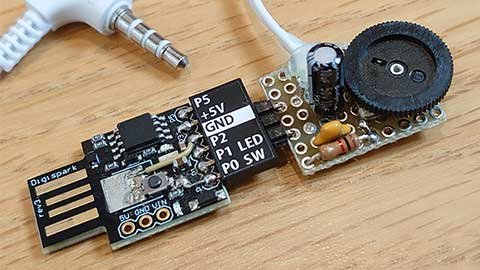Digisparkで音楽演奏【PLL OC1A編】 [Arduino]
以前のスケッチを手直し。
ボードマネージャは、ATTinyCore でも Digistump AVR Boards でも行けるようにしてみた。
8MHzでもなんとか遅延はなさそうで、乾電池2本でも動作できるはず。

結局もう1つ改造Digispark作成。
壊れたイヤホンからケーブルをリユースして録音用パーツを作成。
以下、スケッチ。
次は、矩形波じゃないやつで。
ボードマネージャは、ATTinyCore でも Digistump AVR Boards でも行けるようにしてみた。
8MHzでもなんとか遅延はなさそうで、乾電池2本でも動作できるはず。

結局もう1つ改造Digispark作成。
壊れたイヤホンからケーブルをリユースして録音用パーツを作成。
以下、スケッチ。
// Digispark version Score Replay Sketch
// Clock : 16.5/16/8 MHz, PLL : 66/64 MHz
#include "notes2.h" // Definition data of notes ( pitch (scale & octave), and note value (length))
#include "Kewpie3min.h" // "The Parade of the Tin Soldiers" by Leon Jessel
#define MAX_TRACK 4 // Maximum number of tracks
// Number of cycles that are the wavelength of the basic 12-note scale (from C0 to B0) (@ 8 MHz, with an interrupt every 256 clocks)
static const uint16_t CYC_SCALE[] = { 1911, 1804, 1703, 1607, 1517, 1432, 1351, 1276, 1204, 1136, 1073, 1012 };
void setup(){
pinMode( 1, OUTPUT ); // Audio output (PB1,OC1A)
pinMode( 0, INPUT_PULLUP ); // Switch (PB0)
// *** Register Settings (Timer1, for DAC) *** PLL 64MHz, No prescaling. 8bit=256clock to make PWM, so 250kHz.
TIMSK &= ~_BV(TOIE1); // TIMSK(T/C Interrupt Mask Register) - TOIE1(T/C1 Overflow Interrupt Enable) CLEAR : Disable ISR(TIMER1_OVF_vect) (for Digistump AVR Boards)
PLLCSR |= _BV(PCKE); // PLLCSR(PLL Control and Status Register) - PCKE(PCK Enable) SET : PCK clock(fast 64 MHz) is used as T/C1 clock source
TCCR1 = B01100001; // TCCR1(T/C1 Control Register) : PWM A Enable. OC1A cleared on compare match. OC1A not connected. No prescale
OCR1A = 0; // OCR1A(T/C1 Output Compare RegisterA) : Set output to 0
OCR1C = 255; // OCR1C(T/C1 Output Compare RegisterC) : Set upper limit to 255
// *** Register Settings (Timer0, for Data) *** Data processing interval 31.25kHz(256clk@8MHz or 512clk@16MHz)
TIMSK &= ~_BV(TOIE0); // TIMSK(T/C Interrupt Mask Register) - TOIE0(T/C0 Overflow Interrupt Enable) CLEAR : Disable ISR(TIMER0_OVF_vect) (for ATTinyCore)
TCCR0A = B00000011; // TCCR0A(T/C0 Control Register A) : OC0A/OC0B disconnected, Fast PWM
TCCR0B = B01001010; // TCCR0B(T/C0 Control Register B) : Fast PWM, TOP:OCR0A, clk/8 (From prescaler)
OCR0A = F_CPU / 250000; // OCR0A (T/C0 Output Compare A Register) : TOP 8MHz:32, 16MHz:64, 16.5MHz:66
}
void loop(){
while( digitalRead(0) ); // Wait until the switch is pressed
while( !digitalRead(0) ); // Wait until the switch is released
playDsPLL( Kewpie3min ); // Playback
}
void playDsPLL(const uint16_t *d){ // Digispark PLL version (16.5/16/8 MHz support)
uint8_t Tracks; // Number of tracks
const uint16_t *NoteP[MAX_TRACK]; // Pointer for each track of the score
uint16_t NoteCycle, n; // Number of interrupt cycles required for the length of the reference note (96th note) and its counter (n)
uint16_t note; // Note (pitch + note value) information read from PROGMEM
uint8_t len[MAX_TRACK]; // Length of note (how many 96th notes) (subtraction counter)
uint16_t cyc[MAX_TRACK], c[MAX_TRACK];// Number of interrupt cycles (cyc) required for one sound wavelength cycle and its counter (c)
uint16_t env[MAX_TRACK]; // Sound amplitude (envelope)
uint16_t out[MAX_TRACK]; // Output value
uint8_t lap = 20; // Sound transitional cycles(laptime) (for Attenuation calculator)
// *** Preparing Scores ***
NoteCycle = 8000000 / 256 *4*60 / pgm_read_word_near(d++) / MIN_NOTE; // Number of cycles required for reference note
for( Tracks = 0; Tracks < MAX_TRACK; ) { // Get the number of tracks and the start position of each track from the song data
if( pgm_read_word_near(d++) != 0 ) continue; // Skip until the break comes
if( pgm_read_word_near(d) == 0 ) break; // If two zeros follow, end of data
len[ Tracks ] = 1; // Initialize the note length subtraction counter to the remaining 1
NoteP[ Tracks++ ] = d; // Get location in memory, Count up the number of tracks
}
n = Tracks; // Initialize the score processing so that it can be performed immediately after the start of the do loop
// *** Playback ***
do {
// * Processing Scores *
if( --n < Tracks ) { // Processing of score for each reference note length
if( !--len[n] ) {
note = pgm_read_word_near( NoteP[n]++ );
len[n] = (uint8_t) note; // The lower 8 bits are the length of the note (how many times the length of a 96th note)
cyc[n] = (note>>8) ? CYC_SCALE[ (note>>8) & 0xf ] >> (note>>12) : 0; // Upper 4 bits are octave, next 4 bits are pitch class (0-11), 0 for rests
c[n] = 0; // Initialize the counter for the number of cycles to create one square wave cycle
env[n] = 0xffff; // Initially, the maximum amplitude
}
if( !n ) n = NoteCycle;
}
// * Waveform Processing / Output *
switch( Tracks ) { // Create output data, Square wave with duty ratio of 1:1
case 4: out[3] = ( ( c[3] = (++c[3]==cyc[3]) ? 0 : c[3] ) < (cyc[3]>>1) ) ? env[3] : 0; [[fallthrough]];
case 3: out[2] = ( ( c[2] = (++c[2]==cyc[2]) ? 0 : c[2] ) < (cyc[2]>>1) ) ? env[2] : 0; [[fallthrough]];
case 2: out[1] = ( ( c[1] = (++c[1]==cyc[1]) ? 0 : c[1] ) < (cyc[1]>>1) ) ? env[1] : 0; [[fallthrough]];
case 1: out[0] = ( ( c[0] = (++c[0]==cyc[0]) ? 0 : c[0] ) < (cyc[0]>>1) ) ? env[0] : 0;
}
switch( Tracks ) { // OC1A(ATtiny85:PB1) Change output by number of tracks
case 1: OCR1A = out[0] >>8; break;
case 2: OCR1A = ((out[0]>>1) + (out[1]>>1)) >>8; break;
case 3: OCR1A = ((out[0]>>1) + (out[1]>>2) + (out[2]>>2)) >>8; break;
case 4: OCR1A = ((out[0]>>2) + (out[1]>>2) + (out[2]>>2) + (out[3]>>2)) >>8;
}
switch( --lap ) { // Amplitude attenuation (Distribute processing per loop)
case 4: env[3] -= (env[3]>>9); break;
case 3: env[2] -= (env[2]>>9); break;
case 2: env[1] -= (env[1]>>9); break;
case 1: env[0] -= (env[0]>>9); break;
case 0: lap = 20; // every 640usec(32usec*20) @16MHz (Adjustable)
}
while( !(TIFR & _BV(TOV0)) ); // Waiting for Timer0 overflow (every 32usec)
TIFR |= _BV(TOV0); // Clear T/C0 Overflow Flag
//if( ! digitalRead(0) ) break; // Ends when PB0 is pressed.
if( !(PINB & _BV(0)) ) break; // Ends when PB0 is pressed.
} while( note ); // Exit if note data is 0
OCR1A = 0; // Set output to 0
}
次は、矩形波じゃないやつで。



